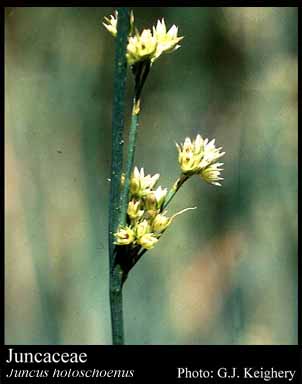- Reference
- Gen.Pl. [Jussieu] 43 (1789)
- Name Status
- Current

Scientific Description
Common name. Rush Family.
Habit and leaf form. Herbs (mostly), or shrubs (a few with woody trunks, e.g. Prionium); evergreen. Usually ‘normal’ plants. Leaves well developed, or much reduced, or absent (rarely). Annual, or perennial; plants with a basal concentration of leaves (usually), or with neither basal nor terminal concentrations of leaves. Young stems cylindrical. When perennial rhizomatous, or tuberous. The shrubby forms pachycaul. Hydrophytic to mesophytic; the aquatics rooted. Leaves when hydrophytic submerged and emergent; alternate; tristichous (nearly always), or distichous (e.g. Distichia); ‘herbaceous’, or leathery, or membranous (sometimes reduced to membranous sheaths); sessile; sheathing. Leaf sheaths with free margins, or with joined margins. Leaves with ‘normal’ orientation (except rarely and atypically in some Juncus species); simple; epulvinate. Leaf blades entire; folded, or rolled, or solid, or flat; acicular, or linear, or subulate, or setaceous; parallel-veined. Leaves ligulate (often, by coalescent apical auricles), or eligulate; with stipules (dubiously, in the form of hyaline lobes on the sides of sheaths), or without stipules; with a persistent basal meristem, and basipetal development. Vegetative anatomy. Plants without silica bodies. Leaf anatomy. Guard-cells not ‘grass type’. Stem anatomy. Secondary thickening absent.
Reproductive type, pollination. Fertile flowers hermaphrodite (usually), or functionally male, or functionally female. Unisexual flowers present (rarely), or absent. Plants hermaphrodite (usually), or dioecious (rarely). Floral nectaries absent (nectaries lacking). Anemophilous (usually), or entomophilous (rarely, or autogamous).
Inflorescence and flower features. Flowers aggregated in ‘inflorescences’; in cymes, or in heads, or in corymbs. The terminal inflorescence unit cymose (usually monochasial). Inflorescences scapiflorous (often, more or less — the stems often extending only in relation to flowering), or not scapiflorous; terminal (but sometimes ‘pushed aside’ by an erect leafy bract, so as to appear lateral); panicles, corymbs or heads; spatheate (with one or more spathal bracts). Flowers bracteolate (usually with two prophylls), or ebracteolate; small; regular; (2–)3 merous; cyclic; tetracyclic, or pentacyclic. Perigone tube absent. Hypogynous disk absent. Perianth of ‘tepals’; 3 (rarely), or 6; 1 -whorled (rarely, the inner whorl absent), or 2 -whorled (usually); usually isomerous; free; sepaloid, or petaloid; similar in the two whorls, or different in the two whorls (sometimes very different in size); green, or white, or brown, or purple, or black, or hyaline. Fertile stamens present, or absent (rarely, when flowers female). Androecium 6 (usually), or 2–3 (rarely). Androecial members free of the perianth; all equal; free of one another; 2 -whorled (usually), or 1 -whorled (rarely). Androecium exclusively of fertile stamens. Stamens 2–3, or 6 (usually); reduced in number relative to the adjacent perianth to diplostemonous. Anthers basifixed; non-versatile; dehiscing via longitudinal slits; introrse, or latrorse; appendaged (sometimes, via the connective tip), or unappendaged. Pollen shed in aggregates; in tetrads. Fertile gynoecium present, or absent (rarely flowers male). Gynoecium 3 carpelled. The pistil 1 celled, or 3 celled. Gynoecium syncarpous; synovarious, or synstylovarious; superior. Ovary unilocular, or plurilocular; 1 locular, or 3 locular. The ‘odd’ carpel anterior. Gynoecium stylate (often shortly). Styles 1, or 3; free to partially joined; attenuate from the ovary; apical. Stigmas 2 (brushlike); dry type; papillate; Group II type. Placentation when unilocular parietal, or basal (rarely — Luzula); axile. Ovules in the single cavity when unilocular 3 (Luzula), or 7–100 (usually ‘many’); 3–50 per locule (i.e. to ‘many’); ascending; non-arillate; anatropous.
Fruit and seed features. Fruit non-fleshy; dehiscent (usually), or indehiscent (rarely); a capsule (usually), or capsular-indehiscent. Capsules usually loculicidal. Seeds endospermic. Endosperm not oily. Seeds with starch. Cotyledons 1. Embryo achlorophyllous (2/3); straight (small). Seedling. Hypocotyl internode present, or absent. Mesocotyl absent. Seedling collar not conspicuous. Cotyledon hyperphyll elongated; assimilatory; more or less circular in t.s. Coleoptile absent. Seedling cataphylls absent. First leaf centric, or dorsiventral. Primary root ephemeral.
Physiology, biochemistry. Photosynthetic pathway: C3.
Geography, cytology, number of species. World distribution: Arctic, North and South temperate and tropical mountains. X = (3-)6 or 20(-36). 400 species.
Economic uses, etc. A few species used locally for matting, chair seats, baskets, hats etc.